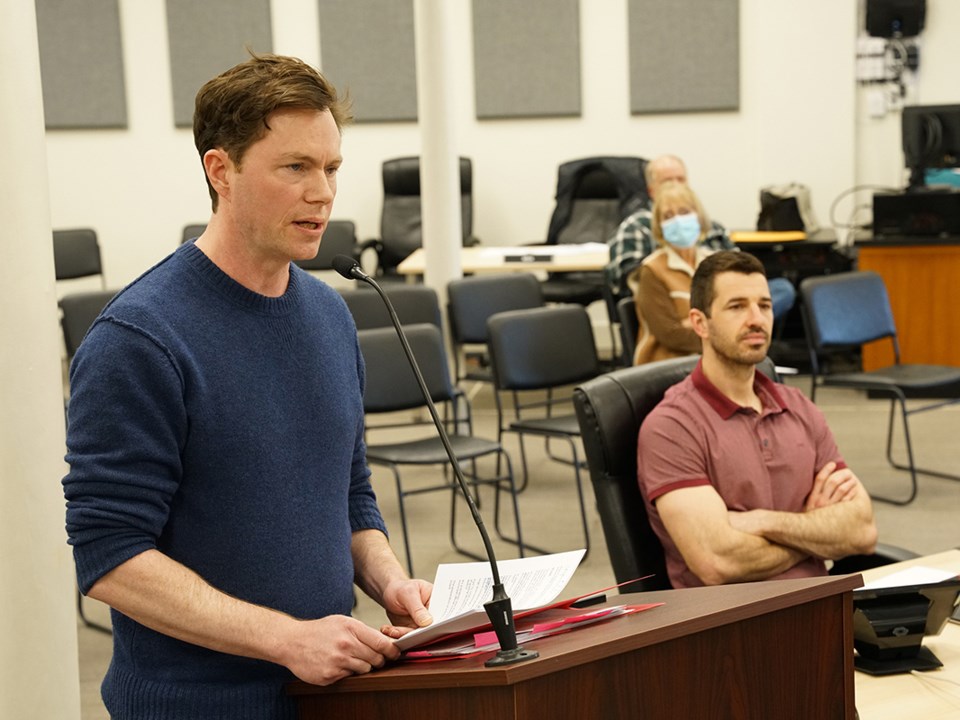City of Powell River staff will prepare a draft policy or an amendment to the city’s fee bylaw that will ensure developers, not taxpayers, pay for work performed in conjunction with complicated planning matters.
At the April 5 committee of the whole meeting, director of planning services Jason Gow provided a report prepared to support council’s decision on whether to direct staff to prepare a municipal boundaries extension proposal for submission to the ministry of municipal affairs.
Gow said on December 14, 2020, committee of the whole received a correspondence package from Grasshopper Developments regarding a formal request for a municipal boundary extension that would see lands the organization owns at 7440 and 7406 Nootka Street annexed to the city from qathet Regional District (qRD) Electoral Area B. Gow said city staff were directed to provide council with a report regarding procedural steps, options, property tax implications and cost recovery opportunities associated with the proposed municipal boundary extension.
In his report, Gow also included information regarding regional growth strategies, which was in response to qRD’s letter requesting that the city postpone consideration of a boundary extension until such time that a collaborative regional growth strategy is adopted.
Gow outlined the municipal boundary extension process to councillors. He said council must prepare a resolution confirming the city is willing to consider an extension proposal and that staff be directed to develop details. Once the proposal is developed further, the city must refer the proposal to other parties for comment, including property owners in the proposed area, to obtain opinions on the proposal. The proposal would also be referred to qRD to determine impact on existing services and details of transferring services should the municipal boundary extension be approved, according to Gow. First Nations must also be consulted.
The second step is a proposal submission, where the municipal boundary extension proposal is submitted to BC Ministry of Municipal Affairs for review, said Gow. It will then be reviewed by the ministry, followed by elector approval, through a referendum or alternative approval process, according to Gow.
If elector approval is received, provincial approval must be sought, followed by implementation, if the boundary extension is approved by cabinet.
Gow said the city has never established a fee to process municipal boundary extension requests, which means costs of staff time would be borne by taxpayers. Gow said specific to Grasshopper Developments, planning services staff have devoted somewhere in the range of 100 hours of time to the proposal.
“As for future costs related to Grasshopper’s request, if council directs staff to prepare a submission to the province, it is recommended that the proponent be permitted to hire an external consultant to prepare the submission,” said Gow. “This approach would minimize the need for staff time and it is supported by the proponent.”
Financial impact
Gow outlined the financial impact of the annexation. He said short-term financial benefits would include increased taxation revenue and development cost charge payments per lot, depending on land use. He said the estimate for the addition of 240 dwelling units in the project could add $565,000 to the city’s general revenue annually. There could also be the one-time payment of $2 million for development cost charges.
“On the surface, these numbers are attractive,” said Gow. “The question is whether they will cover the long-term costs associated with owning, operating and replacing municipal infrastructure in perpetuity.”
Gow said the applicant has submitted a conceptual plan that illustrates the intent to build out the 15.3-hectare (37.8-acre) property. The proposal includes a combination of single-family, townhouse and multifamily residential dwelling units, he said, with a total count of 240 dwellings.
“It is important to remember that the question for council is whether there is interest to direct staff to prepare a municipal boundary extension proposal for submission to the ministry of municipal affairs for consideration,” added Gow. “It is very likely a future council will debate the merits of the land use and density proposed by Grasshopper.”
Gow added that qRD residents who live in the vicinity have expressed concerns about the proposed annexation and development.
Mayor Dave Formosa said he’d like to see the growth and the taxes.
Councillor Jim Palm said regarding the regional growth strategy, it looks like a stall tactic on the part of qRD.
“I’m very happy to hear we can go ahead with this without having to worry about that,” said Palm. “I’m pretty sure the proponent wouldn’t be here if he wasn’t anxious to come into our city boundaries. There are multiple opportunities to help the city out. In my mind, this is a no-brainer for council.”
Councillor George Doubt moved that the committee receive Gow’s report for information and direct staff to prepare a draft policy or an amendment to the city fee bylaw that proposes cost recovery options for complex applications.
The committee voted in favour of the motion.



